THE TOUCAN INTERVIEW
Chris Samnee: The Devil is in the Details, Part 1
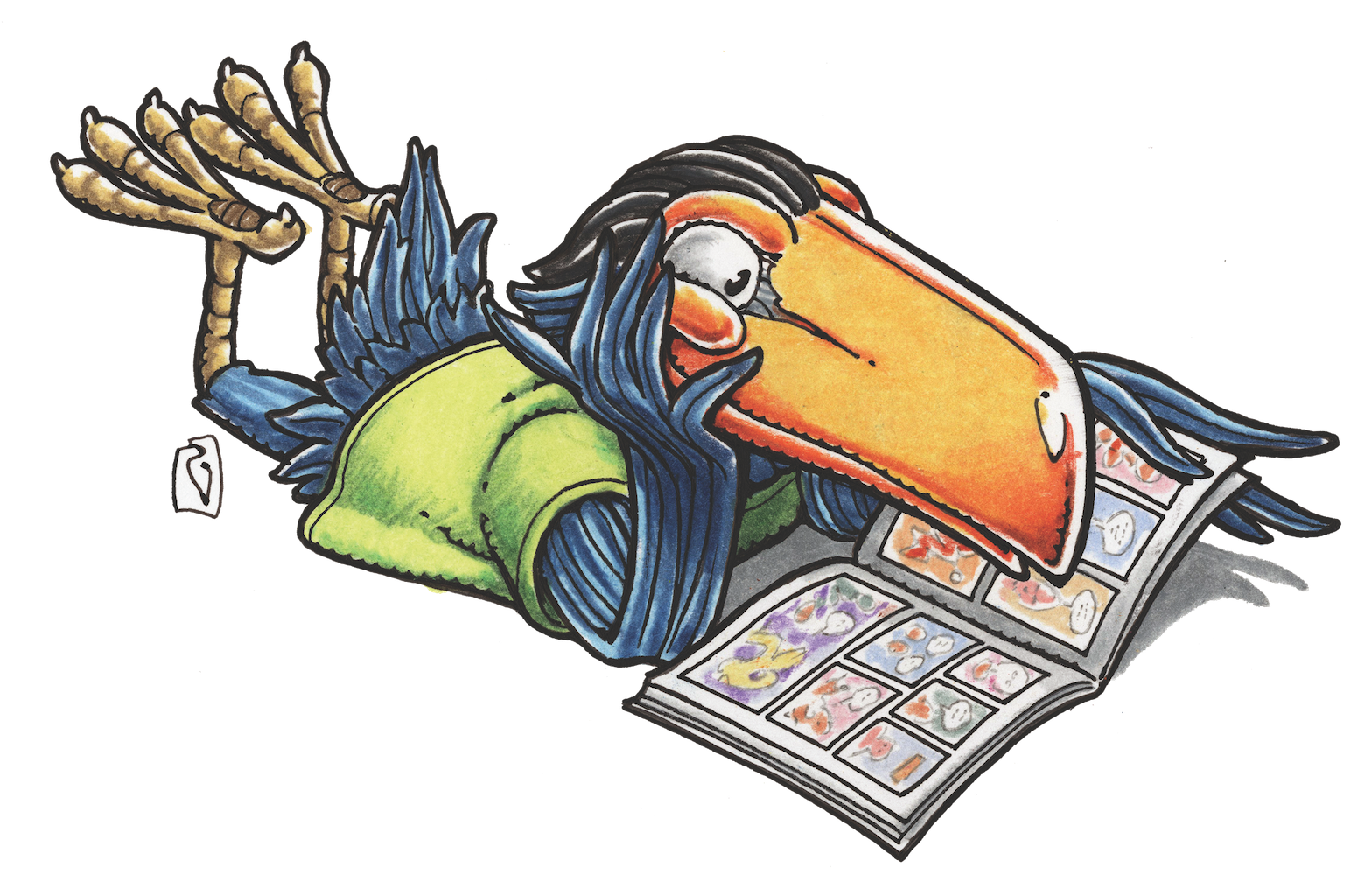
Chris Samnee is one of the hottest artists working in comics right now. The Daredevil penciler/inker is nominated for an Eisner Award this year for his work on the Mark Waid-scripted Marvel series and has also worked with Waid on IDW’s The Rocketeer: Cargo of Doom. In addition, Chris has been doing variant covers for Dynamite, including The Shadow series, and he recently helped launch DC’s The Adventures of Superman digital comic online with writer Jeff Parker. Two things become perfectly clear when talking to Chris: He’s a huge comics fan and he loves what he’s doing. Toucan talked to the artist in early May. Here’s part one of the interview. (As always, click on the images to see them larger on your screen and view in slide show mode.)

Toucan: What are you working on right now?
Chris: I’m working on the first half of layouts for Daredevil #27.
Toucan: And how far ahead is that in the schedule for you? What month will that be released?
Chris: I can’t even keep track. I just turned in the cover for #30, I guess a week and a half ago. So the covers have to be done three months in advance and the issues are usually done maybe a month or a month and a half. We’re thinking way out already. We’re already talking about what’s going to happen past Daredevil #30. So it’s sort of hard to keep track of all of it. I set reminders on my phone to let me know when issues are coming out so I can Tweet about it, or otherwise I wouldn’t be able to keep track at all. I check Man Without Fear and The Other Murdock Papers online. This is where I get my Daredevil news to help me keep track of what I’m doing.
Toucan: You have to look on the Internet to see what you’re doing next.
Chris: Yeah, pretty much.
Toucan: Are you staying with Daredevil indefinitely?
Chris: Yeah. I’m taking a couple issues off for paternity leave and Javier Rodriguez is going to draw issues #28 and #29 and then I’m on from issue #30 for as long as readers will put up with me.
Toucan: I think that’s going to be a very long time. Have you been drawing all your life?
Chris: Well, as far back as I can remember. I got into comics at about 5 or 6 but I remember drawing before that. It was just stick figures and Muppets and stuff like that, but it was comics that really put me on the right path.
Toucan: Do you remember some of your first comic books as a kid?
Chris: I do, actually. My first comic was Batman when I was either 5 or 6. My grandma bought me one of those three packs that you used to get at grocery stores back in the day, and I was like, “They make comics out of these?!” All I’d known was the Super Friends cartoon and I’d had the toys and stuff, I just didn’t know that they came from anywhere. I didn’t realize that there was source material. I just thought that that was just another cartoon that I liked. I thought it was just like Voltron or Robotech, just the stuff that I liked watching. I didn’t realize that there was more that I could get out of it, and I think it’s one thing to see them moving around on screen, it’s another to sort of experience a comic book. You sort of put yourself into it, and at 6 years old I was like this is what I want to do. I don’t know what you call it, I don’t know what it is, but I want to make these.
Toucan: So you realized at a very early age once you started reading comics that somebody actually sat down and drew this and wrote this . . .
Chris: Well I knew that somebody had to make it, it was drawn. I knew that somebody did it, but it took a few years for me to figure out that it was an actual career that someone could have. I knew that it’s what I wanted to do, but if anybody asked me at 7 or 8 years old what I wanted to do I would just say that I wanted to be a cop, because Batman was friends with cops. That was the closest job that I could make sense of. So probably about 10 I realized that this was a job that I could actually have and I started going for it. I found that there was a local St. Louis convention when I was a kid. I think it was Greater Eastern Convention, GEC, something like that, and I talked my parents into driving me the hour and a half away to the airport Holiday Inn where they had the local convention. I started meeting writers and artists and I would just bombard them with as many questions about how they did what they did as I possibly could. There were a couple of artists that were kind enough to tell me what size paper they drew on, and they looked at my Trapper Keeper binder full of looseleaf copy paper and told me what I really needed to be doing if that’s what I wanted to do. So every three or six months there was a convention that I would go to and pester these guys, and I kept doing it month after month after month, and at 15 I got my first published work.
Toucan: Was there somebody at those conventions who was really helpful who was a pro?
Chris: Yeah, Mike Doherty. He was drawing Conan for I think Marvel at the time, and he was the first one to say, “No, you didn’t draw this.” So I drew a Batman sketch for him at his table and he gave me some Marvel board to take home with me and try and draw on, but I was just so in awe of this piece of blank paper that said “Marvel” on the top of it, I couldn’t draw on it. I was just like, “Oh, my god, this is what people draw on!” So I think I still have it somewhere. There’s one aged old piece of white Bristol that I got.
Toucan: With nothing on it.
Chris: With nothing on it, except for the blue lines and the Marvel logo. That was enough for me. From that I couldn’t draw on it.
Toucan: It’s like the Golden Fleece.
Chris: Yeah, it really was. That was what I needed to try. They didn’t make 11 x 17 paper for kids, so I got 11 x 14. I think that was the closest size they had that was just like poster board, and that’s what I started drawing on when I was a kid and going to shows. That was my portfolio . . . a bunch of Bristol board from—I say Bristol, it was poster board from Wal-Mart—that I was drawing Fantastic Four and Batman and stuff on.
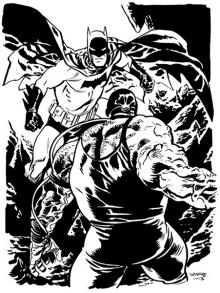
Toucan: Do you remember what the drawing was that you showed Mike Doherty that he said you didn’t draw this?
Chris: Gosh, I think it was mostly Batman. I was Batman crazy from—well, I still kind of am—but I started at 6 and I was just way into anything that was Batman related. But I was copying Tom Mandrake and Jim Aparo, Alan Davis, a lot of the 80s guys, because that’s when I was reading. I got a bunch of beat-up old copies of Gene Colan Batman comics from the flea market. There wasn’t really a whole lot of places to get new comics when I was a kid, so the flea market was my resource for comics. I think it was Batman. It must have been something Batman. I remember drawing a Batman head sketch for him at his table. I think there was the Owl from Daredevil in there, and I can’t remember what else. It was all just on typing paper. I was saying copy paper earlier, but I called it typing paper back then. We didn’t have a computer. We just had a typewriter. Did I just age myself?
Toucan: No, I don’t think so. I noticed doing research for this that you cite a lot of comic strip artists as some of your influences, such as Milton Caniff and particularly Frank Robbins, who I don’t think a lot of artists in your generation really look to as an influence. Where and when did you discover all this great newspaper stuff?
Chris: Well, it was probably around I’d say ’89, ’90, right around there. Again it was my grandma who sort of tried to get me on to new things. She said you like Batman, what about Dick Tracy? What’s Dick Tracy? There was a collection of Dick Tracy strips at the local library near her that she had borrowed and wanted me to take a look at. So, wait . . . it’s not just comics, there are comic strips and comic strips came before comics? I started looking at that, and it was just sort of reverse engineering. I was reading a lot of interviews with pros ever since I was way too little to be reading all these interviews and The Comics Journal. I used to get secondhand copies of Comics Journal and stuff like that, and Jim Aparo said that a big influence on him was Milt Caniff. So I started going backwards from artists that I really loved. What is it about this artist that I really loved, and it turns out they loved something before them, so I would research Jim Aparo’s influences. I really got into Caniff through Aparo. I can’t remember where I came across Frank Robbins. I think I read some of the Invaders stuff that he did and it was really wonky, but I was way into it.
Toucan: And he also did a lot of Batman stuff too.
Chris: Well maybe it’s from Batman. Yeah, well I have one of the early Greatest Batman Stories Ever Told that has the old Man-Bat story that Robbins did. It was sort of like Ditko when I first saw it. Oh, this is perfect . . . this is exactly what comic books are supposed to look like. So I sort of started trying to track down as much of that as I could. There were knowledgeable guys at the flea market. The guy who ran the booth that had all the secondhand comics, he was knowledgeable in old-school stuff. So if I wanted to track anything down, he was able to say if you like that, you should try this. He also got me way into a whole bunch of manga that sort of took my style on a bit of a sideways path there for a few years, but I finally came back around to old-school comics again in the 2000s.
Toucan: You mentioned earlier going to these conventions and getting your first work at 15. What was that?
Chris: It was for Gary Carlson. It was an Image book, I think it was Big Bang Comics. It was like a Silver Age DC throwback, which would be perfect for me now, but at the time I was way into anime and manga. They asked me, do you want to do a Silver Age Batman-like story and I was yes, yeah, all right, I mean, I’ll draw anything. If it’s comics I’ll draw it, but I was still sort of entrenched in all of that. But it was still something. You know, “Hey, do you want to draw eight pages for free?” Comics are that kind of job where you can’t draw them unless you’ve drawn them. So even for free that still meant the world to me. If it wasn’t for my wife, I’d probably still be drawing a bunch of stuff for free. I do this stuff for the love of it and sometimes have to be reminded that it’s also what we do for a living.
Toucan: With all these influences that you have that are comic strip artists, do you have any ambition to actually do a newspaper strip? I mean, the day of the adventure strips seems to have passed, but I think you’d do a pretty great Tarzan.
Chris: I think syndicated strips are hard to get into and are also on their way out. I don’t think that I’d try to get into print newspaper strips, but in the back of mind I have an adventure story that I’d like to do in the strip format, but maybe do digitally. Get people into the idea of what adventure strips like Terry and the Pirates were back in the day, but have it for our generation where anybody can get a hold of it nowadays, the way that they were able to get a hold of a newspaper back in the day, but for the iPad. I mean, nearly everybody has an iPad nowadays. That’s the easiest way to go about it, I think. Mark Waid doing Thrillbent is making it even easier for pros to jump in and test the waters on stuff like that. So one of these days when I have a bit of free time. We have our second baby due in about a month. So free time is in short supply at the moment. So somewhere down the line I’ll try and do some creator-owned work.
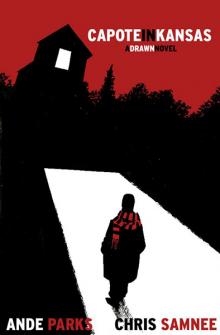
Toucan: The first time I saw your art was on the Oni Press graphic novel Capote in Kansas. Was that one of the first things you did after Big Bang?
Chris: I’d done a few things for AC Comics. It’s not in my bio, but I actually did a few issues of FemForce. So that was more free work that I was just trying to climb my way up the rungs. For a while I was a barista at Borders. I’ve had loads of crummy jobs. I was a flea market caricature artist, a pizza cook, a cable guy, and a half a dozen other things in between, but all the while, I didn’t want to take on a career, I just wanted some sort of job to keep me in clothes while I was making comics. So, yeah . . . I was a barista at Borders while I was working on FemForce and while I was working on Capote as well. I worked on that from 2004 or 2005. It came out in 2006, I think, somewhere around there. A lot of long nights, but Capote was probably the biggest blip that my career had had in all those years. I guess I was 23 when Capote came out. And then it sort of snowballed from there.
Toucan: And amazingly your style seemed to be pretty much in full force. You can look at Capote in Kansas and while you’re a much better artist now, you can see who you are now in that work too. It’s like your style was pretty much fully developed.
Chris: Well, up until that point I just wanted to be a penciler and my style had a lot more lines in it. I was way into guys who could do really detailed stuff. I can’t even imagine trying to be that sort of artist nowadays, but I still look at Bryan Hitch and Geof Darrow, guys that are super detailed or really rendered. That stuff is amazing to me, but it’s something that I just can’t do or don’t have the patience for. But when I took on the job I didn’t realized that I wasn’t going to have an inker. They were like, “Oh, no we don’t have a budget for an inker,” so it was just baptism by fire. If that book was going to get done, I had to ink it. So I had to learn real fast. I went out, I bought India ink and a bunch of the wrong brushes and just had to start figuring it out. I had a bunch of wedge tipped brushes that I thought would make it look like an old comic and it didn’t look right. But 128 pages will definitely make you figure out how to ink. My style sort of came from being super nervous and I was judging every single line that I put down on the paper, because having Ande [Parks, the writer of Capote in Kansas] being such a big name inker, I was just afraid to screw it up. I didn’t want him to see me do a bad job. So that’s where I started blowing out the one side, where the light source would come from, sort of the chiaroscuro. I was looking at David Lloyd and Jim Steranko and some of the stuff that they could do with just the shadows and I started trying to do some of that because that meant that was one less line that I had to screw up on a page. And that’s sort of what my style is built on. It’s just . . . it’s just fear (laughs). I was just afraid of screwing it up, but it became my style.
Toucan: And because of that, now do you prefer to ink your own stuff?
Chris: Oh yeah. My pencils are just awful. I can’t imagine anybody else inking me nowadays because most of the work is done in the ink.
Toucan: After Capote you did Queen and Country, which I think was at the very end of that series.
Chris: Actually, after I did Capote I was still at Borders and I signed on to do a Vertigo graphic novel. But they plan things so far ahead at DC/Vertigo that I’d signed my contract and I was waiting for like six months to get scripts while the writer was still working on it. So while I was waiting on scripts for the graphic novel—I didn’t know how slow things worked in comics at the time—I kept on emailing my editor and saying while I’m waiting, do you have anything? So I did a couple of short stories and American Splendor when Vertigo was still doing it with Harvey Pekar and an issue of Exterminators that Tony Moore recommended me for, because that’s what he was working on at the time. I did three issues of Queen and Country and then Greg Rucka did 52. So in the year that he was doing 52, I did Area 10 for Vertigo and then came back and did the last issue of Queen and Country after.
Toucan: So Area 10 was the graphic novel for Vertigo?
Chris: Yeah. It was for Vertigo Prime, but it didn’t come out until 2008, 2009. So when it came out I was like here’s a book that I did several years ago everybody.
Toucan: And somewhere in there you did The Mighty for DC too?
Chris: Yeah, I think that was 2009. I actually just met Pete Tomasi in person at a convention this past weekend. We worked together on eight issues of The Mighty and a couple of short stories for Blackest Night in the Green Lantern series that he recommended me for because he’s a good guy. I think he just found me through my blog of all things. Five days a week I was doing a sketch on my blog because I’m always trying to get better, and whenever I have free time, I’ll sketch. And he just liked what he saw in there and said that he had a creator-owned book at DC and the current artist, Peter Snejbjerg, wasn’t able to continue on it—he was going to go do I think Battlegrounds, one of the war books that Garth Ennis was doing at the time. Pete needed someone to come in and finish the series for him. So I jumped in and did some proper superhero comics for a while.
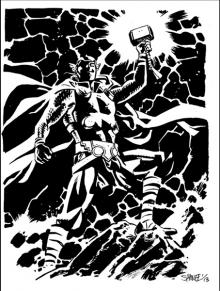
Toucan: So probably the thing that really put you on the map though, superhero wise, was the Marvel’s Thor the Mighty Avenger series with Roger Langridge, which was kind of an all-ages book but actually seemed more like an adult superhero series with kind of an indie sensibility. That book went away pretty suddenly and it’s still kind of sadly missed. What are your memories about working on that?
Chris: Oh gosh, it was so much fun. I was offered the job by Nate Cosby and at the time I just thought “Thor book, no.” I mean I wasn’t in the position to ever say no to anything. So I said sure, but I remember thinking Thor doesn’t seem like the right book for me, and then I started reading Roger’s synopsis and almost right away it was like, oh, well this isn’t the hot-headed Thor that I remember from when I was a kid. And it was a lot more, there was more heart to it. It felt personal as opposed to just gods and monsters. There was some of that too, but it just felt like . . . I don’t know it could be a novel that you would read and it just happened to have a little bit of the superhero in it. It was a really good time. I’m still friends with Roger. I emailed him a couple of weeks ago. Matt Wilson, my colorist on it, is still one of my best friends, and any time that I have something pop up that needs to be colored Matt’s always my go-to guy. He did some Planet of the Apes for me, a cover two months ago ,and he just colored the Adventures of Superman story I did. It still tears me up that we didn’t get to finish our run on Thor the Mighty Avenger. But you know, we got canceled and I was getting ready to move on to Ultimate Spider-Man and I managed to squeeze out that Free Comic Book Day issue right before I did Ultimate Spider-Man. It was a tight deadline, but I begged for Free Comic Book Day book and we got our ninth issue. But yeah, man, it was a hell of a time.
Toucan: The great thing about that series—you’re talking about it as being almost like a novel. It was very romantic, too, which you don’t see in a lot of superhero books.
Chris: Yeah. I think there are just as many female fans of Thor the Mighty Avenger as there are male, and a lot of kids. Folks like to send me pictures of their kids reading a copy of Thor the Mighty Avenger. It’s great to see kids reading it but it’s sort of heartbreaking because there aren’t a whole lot of comics that kids can read these days. There’s so many uberviolent or monsters throwing up blood, or just so many things that I just don’t think are appropriate for kids. I may be thinking more of that because I have a second on the way. I want the market to be inclusive of more readers, and we need to have a keener eye towards younger readers because they’re going to be the adult readers in a few years. There’s only so long that we can keep catering to 40- and 50-year old men. They’re going to age out eventually.
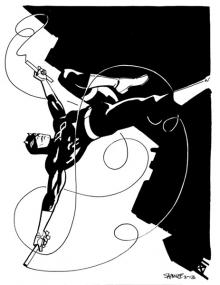
Toucan: You’ve worked with some really great writers so far in your career, Mark Waid, Roger Langridge, Greg Rucka. The first interview we did for Toucan was with Mark Waid and we asked him what makes a great writer/artist team and his answer was “communication and total trust, realizing that it’s collaborative medium and nobody bringing any ego to the table is what makes it work.” What do you think makes a great writer/artist team?
Chris: Oh, my gosh, can I just cut and paste that one, that’s perfect. That’s almost exactly what I’ve said in the past. You have to be able to trust your writer and the writer has to be able to trust you; and Mark and I, that’s the sort of relationship we have. We talk on the phone before every issue starts and we email each other and talk once or twice a week just to touch base. Sometimes I’ll think of a different layout or I’ll need to add a couple of panels; right now we’re doing issue #27 and I still don’t know where it’s going to end. We were talking at the convention this past weekend on how the issue was going to end, but we didn’t know how to get there. And I’m working on page 10 and Mark’s writing 11 to 20 at home right now and we’re supposed to talk about the rest of the beats for the issue tonight. I don’t think we’d be able to do that if we didn’t trust each other. He trusts me that I’m going to try and make him look good, and he makes me look good. So yeah . . . everything that Mark said is spot on.
Toucan: What’s your working procedure like with him? Obviously, if he’s still working on the back half of that issue you don’t get a full script in advance.
Chris: Well, ideally I’d get a full script, and I’ve gotten a few full scripts in the past 12 issues or so that I’ve done now, but he’s a busy guy. I mean between Thrillbent and Hulk and the Marvel digital stuff that he’s doing and Daredevil, he’s spinning a lot of plates, not to mention he also has the two issues that Javier is drawing that have to be done while I’m working on mine. So he’s trying to write #27, #28, and #29 all at the same time. Javier and I are both getting scripts piecemeal so that he can keep us both working. So this issue isn’t common. This is a little different than usual. But usually I get a full script and . . . well, let’s go back a little bit. He’ll come up with an idea or we’ll spitball a little bit of something on the phone and then he goes off and writes it. He sends me nearly a full script, and then I take a couple of days and do a layout. Two days minimum, 5 days tops, for 20 pages, and I tighten up whatever I need to in pencil and then ink that and send it off to everybody. But along the way we chat on the phone. I’ll email him any questions that I have about the script or changes that I think we need for pacing, and most of the time the trust comes in and I trust him, he trusts me, and we just say, okay we’ll make it work.
Toucan: Is there a lot of descriptive information in his scripts? Daredevil swinging over the city or something like that?
Chris: It’s usually just the right amount. Some guys will try to dictate camera angle and that’s all a little bit too much, I think. I just need the bare minimum. The dialogue helps me know the emotion of the character. and if there’s just a sentence or so describing the panel, like whenever we start a new location, it’s a couple of sentences to set things up, but usually it’s just “back on Daredevil,” or “over Daredevil’s shoulder” and then just something short and sweet just so I know what needs to be in each panel and I can keep on going. But I’m supposed to be the cinematographer and the choreographer and all that stuff. So he leaves all that stuff up to me.